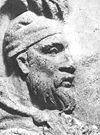- Moskon
-
Moskon was a Getic king who ruled in the 3rd century BC the northern parts of Dobruja, probably being the head of a local tribal union, which had close relations with the local Greek colonies and adopted the Greek style of administration.
The only proofs of his existence are some silver coins found near Tulcea, all of them featuring the head of a young man with long hair and a tiara and a horseman on the reverse, with the writing ΒΑΣΙΛΕΩΣ ΜΟΣΚΩΝΟΣ, Basileos Moskonos, i.e. King Moskon.
References
- C. Preda, SCIV XV (1964), 401-410; idem, Fasti Archeologici XVII (1965), p. 237 nr.3353
- Radu Ocheşeanu, Monedele basileului Moskon aflate în colecţiile Muzeului de arheologie Constanţa (=Coins of Basileus Moskon in the collections of the Archaeological Museum at Constantza), în Pontica 3 (1970), p. 125-128.
- Dicţionar de istorie veche a României ("Dictionary of ancient Romanian history") (1976) Editura Ştiinţifică şi Enciclopedică, pp. 416
Dacia topics Dacian tribes: Aedi · Albocense · Anartes · Apuli · Artakioi · Biephi · Biessoi · Buri · Carpi · Cauci · Ciaginsi · Clariae · Costoboci · Cotini · Crobidae · Daci · Getae · Moesi · Osi · Peukini · Piephigi · Potulatense · Predasense · Rhadacense · Saldense · Scaugdae · Sense · Suci · Terizi · Teurisci · Trixae · Tyragetae · Troglodytae
Dacian kings: Culture and civilisation: Art, jewellery, treasures, tools (Bracelets) · Clothing · Foreign Relations (Greeks · Celts · Romans · Germanic tribes) · Warfare (Falx · Sica · Thracian warfare)
Sarmizegetusa · Argidava · Buridava · Cumidava · Piroboridava · Sucidava · More towns... · Davae · Dacian Fortresses of the Orăştie Mountains · Murus dacicusWars with the
Roman Empire:Roman Dacia: Dacia Traiana · Moesia · Scythia Minor · Dacia Aureliana · Diocese of Dacia · Dacia Mediterranea · Dacia Ripensis · Trajan (Bridge · Column) · Towns and cities · Castra · Limes (Alutanus · Moesiae · Porolissensis · Sarmatiae · Transalutanus · Trajan's Wall · Brazda lui Novac) · Language (Thraco-Roman · Eastern Romance substratum)Research on Dacia: Books about Dacia · Dacian archaeology · Archaeological sites in Romania · Dacology · Thracology · ProtochronismWikiProject • Commons • Dacian fortresses, settlements, Roman castra, limes from Romania: Google Maps • Google EarthCategories:- Dobruja
- Dacian kings
- European royalty stubs
Wikimedia Foundation. 2010.
